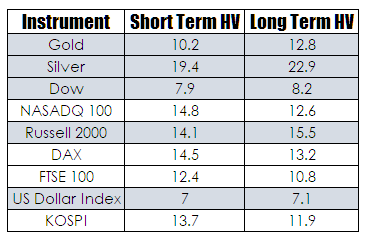With the situation on the Korean Peninsula threatening to give us another 9 years of MASH and with our own politician desperately trying to find relevance on the world stage by injecting themselves into the crisis I thought it might be interesting to see how markets viewed what was going on. Markets traditionally respond to uncertainty with a lift in volatility – this lift reflects not only the uncertainty but also the need to be compensated for the risk associated with this uncertainty. If things are really bad then markets lift volatility across the board. So to see if this was happening I took a small snapshot of major markets, looked at their 30 day historical volatility and then compared that with their long term average volatility. I have marked those markets that are currently experiencing relatively low volatility in blue. The results of my straw poll can be seen in the table below.
Intriguingly the worlds largest market doesn’t seem to think much of the crisis, nor does gold which is usually seen as a barometer of such things. As to what these means I have no idea and historical precedents are not much help since it offers a slightly different picture. At the outbreak of the original conflict in 1950 volatility went through the roof but during the Cuban missile Crisis which our idiot politicians are trying to compare it to only had an increase in volatility after the crisis ended and markets were recovering.
So what does it all mean? I have no idea but since it is only observational and not predictive it doesn’t really matter.







